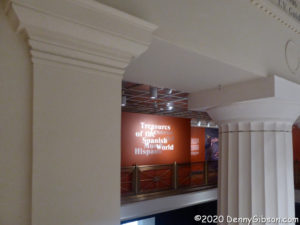 When the Cincinnati Art Museum announced this upcoming exhibit near summer’s end, I was interested but not overly so. In fact, I didn’t put it on my Gotta-See-That list but on my I’ll-See-That-If-It’s-Convenient list. That was a mistake and I’m sure glad there was a day when taking in Treasures of the Spanish World was convenient and it didn’t end up on my Sorry-I-Missed-That list.
When the Cincinnati Art Museum announced this upcoming exhibit near summer’s end, I was interested but not overly so. In fact, I didn’t put it on my Gotta-See-That list but on my I’ll-See-That-If-It’s-Convenient list. That was a mistake and I’m sure glad there was a day when taking in Treasures of the Spanish World was convenient and it didn’t end up on my Sorry-I-Missed-That list.
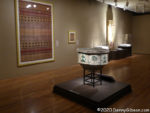
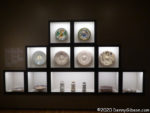
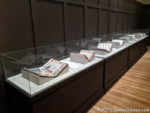 First off, it’s big. Its more than 200 objects fill several of the galleries I associate with temporary exhibits. And it’s not just big in terms of space but in time as well. The oldest items in the exhibit are from the middle of the third millennium BCE; The newest are from the twentieth century CE. Most items, including intricately decorated fabrics and ceramics, call for some up-close study. The pictured “books” are letters patent of nobility (cartas ejecutorias de hidalguia) that attest to “the holder’s gentility” and social position. They are wonderfully decorated and often contain images of the holder and/or grantor.
First off, it’s big. Its more than 200 objects fill several of the galleries I associate with temporary exhibits. And it’s not just big in terms of space but in time as well. The oldest items in the exhibit are from the middle of the third millennium BCE; The newest are from the twentieth century CE. Most items, including intricately decorated fabrics and ceramics, call for some up-close study. The pictured “books” are letters patent of nobility (cartas ejecutorias de hidalguia) that attest to “the holder’s gentility” and social position. They are wonderfully decorated and often contain images of the holder and/or grantor.
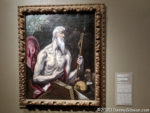
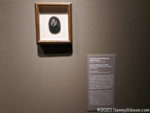 Numerous paintings, including quite a few portraits, are on display. These, showing a wide range of scale, are the work of Domenikos Theotokopoulos (a.k.a, El Greco).
Numerous paintings, including quite a few portraits, are on display. These, showing a wide range of scale, are the work of Domenikos Theotokopoulos (a.k.a, El Greco).
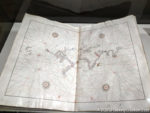
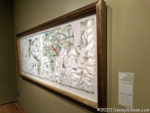
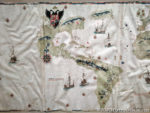 At the beginning of a section named “Golden Age“, visitors are reminded that “In the 1500s Spain was the most powerful country in the western world”. The western world was getting a whole lot bigger in those days and Spain played a huge role in that. The large map, from which the clip of the Americas was taken, was created by Giovanni Vespucci in 1526 as a royal wedding gift. Giovanni inherited the job of maintaining Spain’s master nautical chart from his uncle, Amerigo.
At the beginning of a section named “Golden Age“, visitors are reminded that “In the 1500s Spain was the most powerful country in the western world”. The western world was getting a whole lot bigger in those days and Spain played a huge role in that. The large map, from which the clip of the Americas was taken, was created by Giovanni Vespucci in 1526 as a royal wedding gift. Giovanni inherited the job of maintaining Spain’s master nautical chart from his uncle, Amerigo.
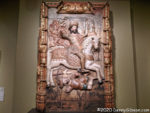
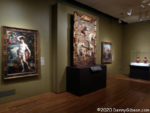 Of course, Christianity was really big in both Old and New Spain. The large wooden relief sculpture was once part of an even larger piece in a Mexican Church. It dates from around 1600.
Of course, Christianity was really big in both Old and New Spain. The large wooden relief sculpture was once part of an even larger piece in a Mexican Church. It dates from around 1600.
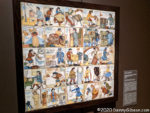 The exhibit is organized chronologically and physically divided into two parts. The second section is certainly interesting enough — there are a few Goyas among its several paintings — but I only have one photo from it. I seem to like my history with a side of art more than the other way round. “Advances of the Nineteenth Century” is a set of tiles recounting recent progress from the vantage point of 1903. The bicycle, locomotive, flush toilet, and sewing machine are clearly steps forward. Not so clear is whatever advance the bullfighting tile is touting.
The exhibit is organized chronologically and physically divided into two parts. The second section is certainly interesting enough — there are a few Goyas among its several paintings — but I only have one photo from it. I seem to like my history with a side of art more than the other way round. “Advances of the Nineteenth Century” is a set of tiles recounting recent progress from the vantage point of 1903. The bicycle, locomotive, flush toilet, and sewing machine are clearly steps forward. Not so clear is whatever advance the bullfighting tile is touting.
This touring exhibit was made possible by a major renovation project at the Hispanic Society Museum & Library in New York City. That’s where the items in the exhibit normally appear and many of them have never been displayed elsewhere. The exhibit initially appeared in Madrid, Spain, and appeared in Mexico City and Albuquerque before reaching Cincinnati. There’s still time to see it but not much. This is being published when just one week of the fourteen-week run remains. As I said in the opening paragraph, I’m glad Treasures of the Spanish World avoided going on my Sorry-I-Missed-That list. I recommend you keep it off of yours, too, if you can.
